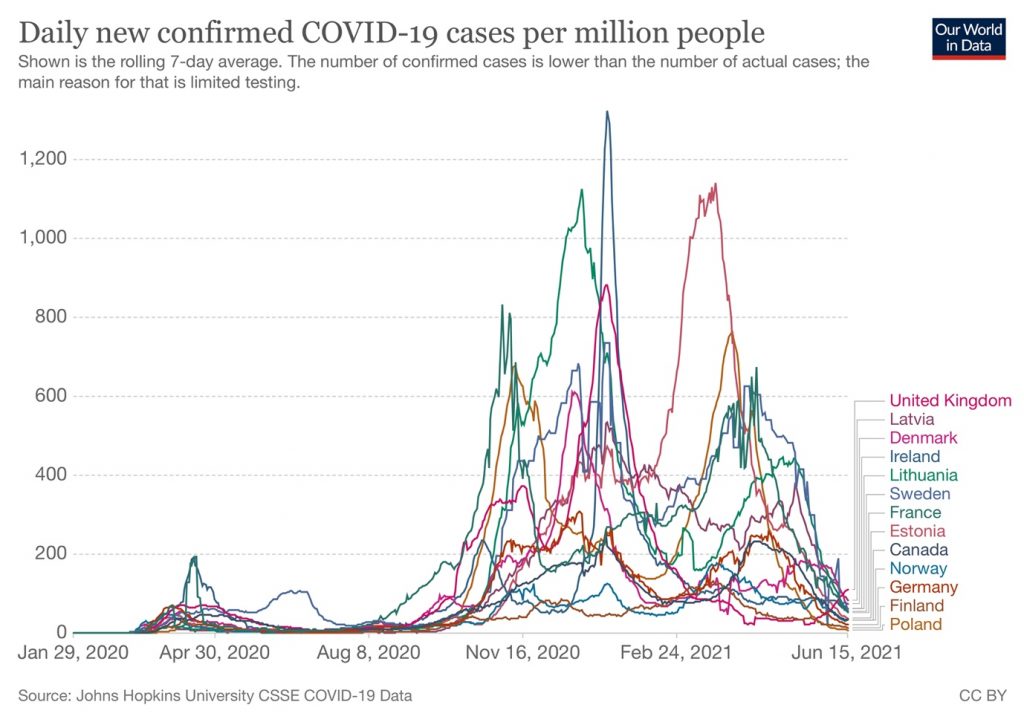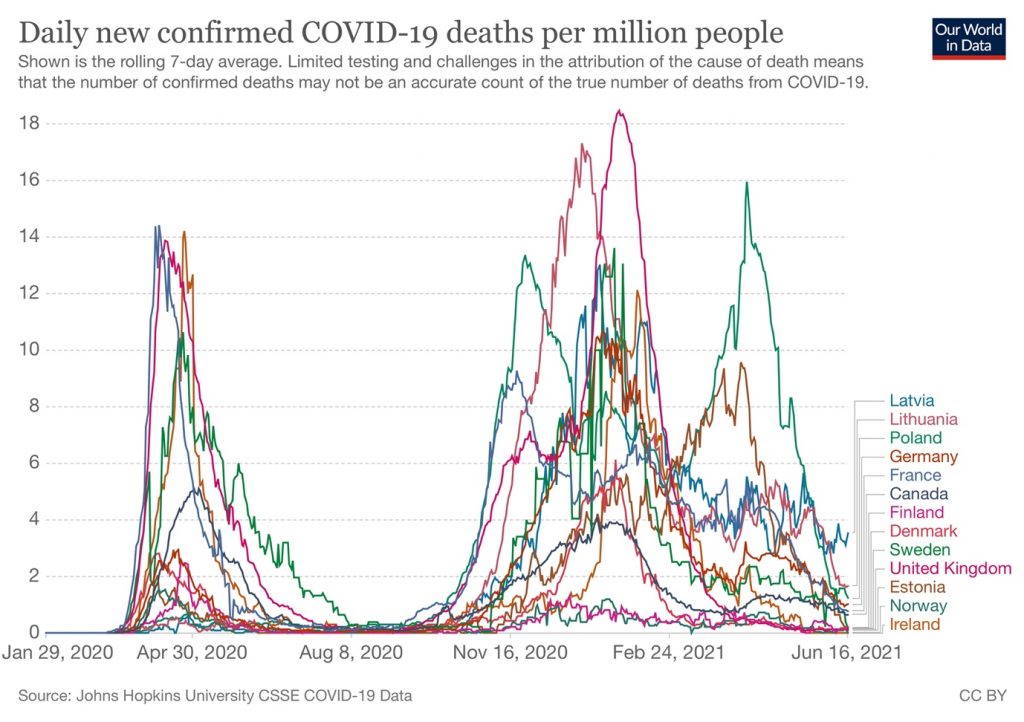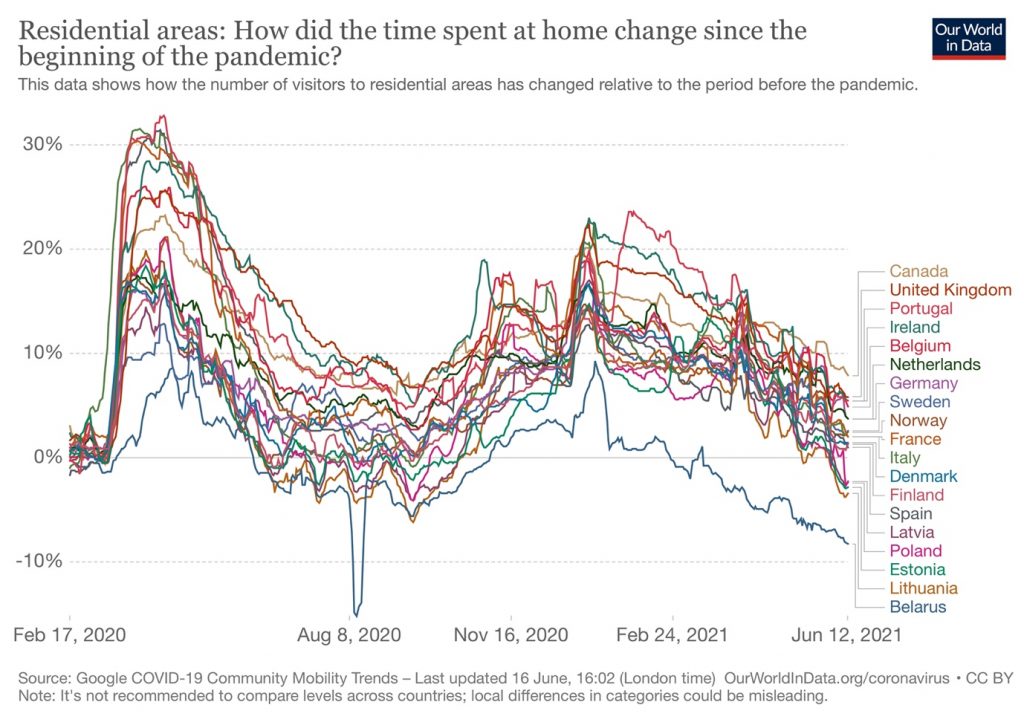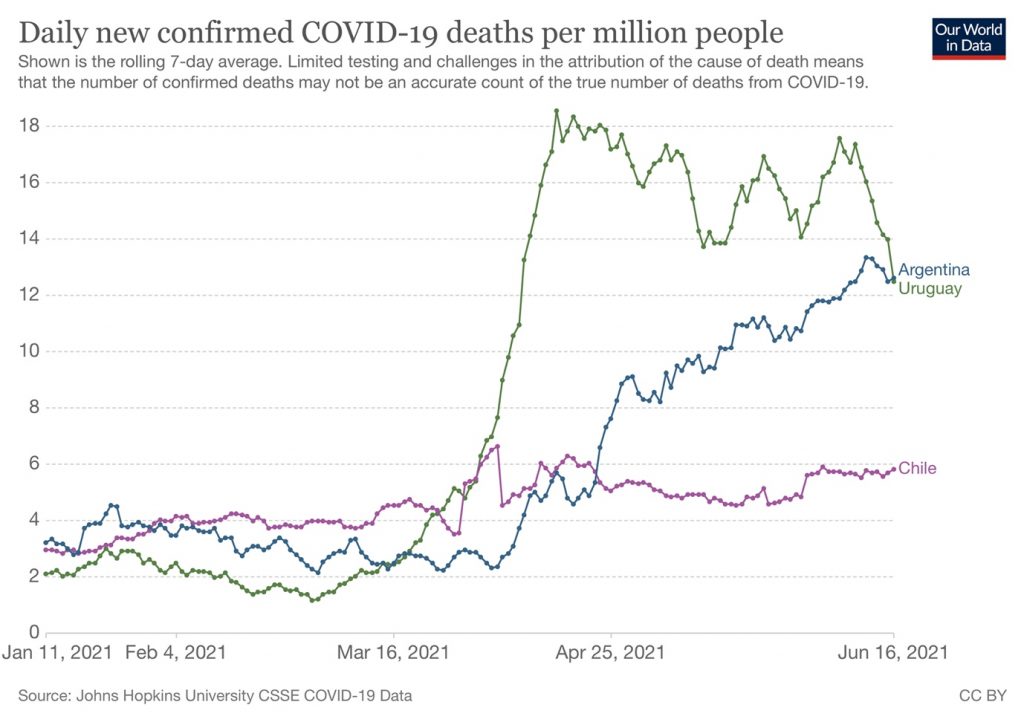The pre-Covid scientific literature indicates there are already four known coronaviruses in circulation, which are – like ’flu – predominantly seasonal in the northern temperate climatic zones, which include Northern Europe and the north part of North America. Although not entirely without exception, the typical pattern – as has been pointed out previously in Lockdown Sceptics – is for coronavirus infections to peak between late autumn and early spring and dwindle away in the summer.
Scientific parsimony would – in the absence of evidence to the contrary – lead us to anticipate SARS-CoV-2 would behave in the same way. Indeed, infections in Spring 2020 did follow the typical pattern. Although peaking earlier or later in different places, infections fell to a baseline before picking up again from the autumn – including in countries of Eastern Europe that escaped the first wave altogether.

Reported deaths followed a similar pattern.

In the autumn and winter of 2020-21 positives and deaths again peaked, with shouldered or distributed peaks in some areas. This is not unusual for seasonal respiratory virus outbreaks as can be seen in the excess deaths reported to EUROMOMO during the 2017-8 ’flu season, for example (small summer peaks in excess deaths are attributed to heatwaves).

What would be unexpected, other than in quite exceptional circumstances, would be substantial peaks in excess deaths in summer caused by seasonal respiratory virus outbreaks.
Has the ‘third wave’ already begun?
According to a BBC report of June 14th, postponement of Freedom Day on June 21st was because infections could hit January levels by the end of July. The REACT study of May 20th-June 7th also indicated an exponential rise in infections and Professor Tim Spector reported a doubling of infections in a week based on the ZOE symptom study of June 9th.
However, the most recent ZOE update indicates infections are not rising as fast as they were and the Government may have cancelled Freedom Day prematurely on the basis of out-of-date data.
Freedom is slavery day?
Does the recent rise in infections in the UK – despite mass vaccination and Non-Pharmaceutical Interventions (NPIs) – presage a substantial third wave in the summer? Does this rise effectively falsify the seasonality hypothesis?
Well, according to the Government’s own data, percent positivity in England is reported at 2.7 for the most recent available day (June 15th), having more than doubled from 1.3 on June 15th. Infections – number of positive tests reported – present a more complicated picture. They leapt to around 9,000 per day in England from 17th to June 18th, having almost plateaued at about 6,500 the week before. However, this jump occurred after the Government’s announcement of June 14th and may already be about to decline. The percentage change in the 7-day case rate has shown a steady fall since June 7th.

If the current trend continues – as your mainstream media ‘science’ correspondent might like to put it – positives recorded will start to fall despite further recent warnings discussed in Lockdown Sceptics.
There are still a few more weeks of spring left to see if infections do finally dwindle away for the summer at all northern latitudes.
The NPIs currently mandated have been in place through the current rise – attributed to circulation of the more infectious Delta variant among the unvaccinated – and are unlikely to dampen it. Seeding of the Delta variant has occurred in the majority of European Union countries, including, for example, in Sweden and Germany, offering numerous comparative controls for U.K. trends, both by age and vaccination status.
Is there an alternative explanation for the current rise in cases? One may be that summer circulation of apparently seasonal respiratory viruses has occurred previously, but at such a level that it was not detected and did not lead to noticeable increases in morbidity and mortality. Testing for SARS-CoV-2 is so prolific compared to testing for any respiratory virus in the past that it is quite possible such circulation would have been missed.
Another explanation may be that lockdowns have actually hindered seasonal decline in infections. It is interesting to note that the UK and Portugal – where there has also been a recent increase in cases – both report high relative increases in time spent at home according to mobility data. It is tempting to speculate how dragging out restrictions may have fostered indoor spread of the Delta variant!

Seasonality versus intervention?
The next few weeks are scientifically – and politically – very important. The Government has cancelled Freedom Day on the basis of claims that a new wave has arisen due to transmission of the more infectious Delta variant mainly amongst the unvaccinated. It is concerned this wave could threaten the NHS, despite prolongation of existing NPI measures intended to reduce infection while vaccine uptake proceeds more broadly.
If there is a substantial third wave it will have been proven right, and may be further vindicated by similar patterns of infection occurring in other northern countries already seeded with the Delta variant.
However, if 2021 does follow the 2020 pattern, with infections falling imminently in the U.K. and continuing to do so throughout northern latitudes, regardless of vaccine uptake and with and without the Delta variant, the parsimonious explanation – that seasonality drives any substantial variation in infections – will stand.
Although extrapolating assumptions about seasonality to other regions is not straightforward, the more southerly parts of South America have shown autumn resurgences in deaths, despite quite advanced vaccination programmes. The efficacy of the vaccines used is disputed, however.

Although the U.K. vaccination programme is claimed to be effective in preventing serious morbidity and mortality from current variants, for reasons alluded to above, it will not be until the autumn and winter of 2021-2 that the effectiveness of the U.K. vaccination programme will be fully confirmed.
If it is not, the Government will be shown to have abandoned the pandemic preparedness guidelines for an edifice built on sand (as its experts may already have implicitly acknowledged).
This article is co-authored by a retired Professor of Forensic Science and Biological Anthropology and an epidemiologist with a PhD from a Russell Group university.










Donate
We depend on your donations to keep this site going. Please give what you can.
Donate TodayComment on this Article
You’ll need to set up an account to comment if you don’t already have one. We ask for a minimum donation of £5 if you'd like to make a comment or post in our Forums.
Sign Up“Your Obedience Is Prolonging This Nightmare”: Protesters March in London against Delay to “Freedom Day”
Next PostDoes the Current Rise in Infections Prove the Virus isn’t Seasonal?